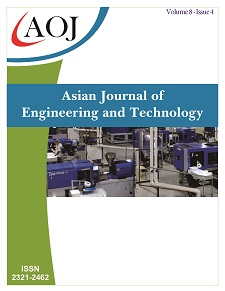Application of an Innovate Energy Balance to Investigate Viscoelastic Problems
DOI:
https://doi.org/10.24203/ajet.v8i4.6404Keywords:
Energy Balance; Residual Energy; Non-inertial energy; ViscoelasticityAbstract
Modeling and investigating of energy distribution especially the wasted one is very important in viscoelastic problems. In this article, an applied energy model based on separation of energy components of the system is extracted and expanded to apply in linear viscoelastic problems, although this method is applicable in nonlinear problems as well. It is assumed that the whole energy of the system can be divided into two parts: Residual and non-inertial energies. The non-inertial energy is the sum of the energies that do not depend on the inertia of the system, while residual energy is the remaining of total energy. When an amount of energy is applied to the system, by determining the non-inertial energy from a novel energy conservation equation, the residual energy can be calculated. Some basic viscoelastic examples are investigated and obtained results will be compared with the expected ones.
References
Caputo, Michele, and Francesco Mainardi. "A new dissipation model based on memory mechanism." Pure and Applied Geophysics 91.1 (1971): 134-147.
Del Piero, Gianpietro, and Luca Deseri. "On the concepts of state and free energy in linear viscoelasticity." Archive for Rational Mechanics and Analysis 138.1 (1997): 1-35.
Colinas-Armijo, Natalia, Mario Di Paola, and Francesco P. Pinnola. "Fractional characteristic times and dissipated energy in fractional linear viscoelasticity." Communications in Nonlinear Science and Numerical Simulation 37 (2016): 14-30.
Bland, David Russell. The theory of linear viscoelasticity. Courier Dover Publications, 2016.
Hongbin, Yang, et al. "Energy dissipation behaviors of a dispersed viscoelastic microsphere system." Colloids and Surfaces A: Physicochemical and Engineering Aspects 487 (2015): 240-245.
Fabrizio, Mauro, and Angelo Morro. Mathematical problems in linear viscoelasticity. Vol. 12. Siam, 1992.
Deseri, Luca, Giorgio Gentili, and Murrough Golden. "An explicit formula for the minimum free energy in linear viscoelasticity." Journal of elasticity 54.2 (1999): 141-185.
Tschoegl, Nicholas W., Wolfgang G. Knauss, and Igor Emri. "Poisson's ratio in linear viscoelasticity–a critical review." Mechanics of Time-Dependent Materials 6.1 (2002): 3-51.
Lei, Zhen, Chun Liu, and Yi Zhou. "Global existence for a 2D incompressible viscoelastic model with small strain." Communications in Mathematical Sciences 5.3 (2007): 595-616.
Ghayesh, Mergen H. "Dynamics of functionally graded viscoelastic microbeams." International Journal of Engineering Science 124 (2018): 115-131.
Likhtman, Alexei E., Sathish K. Sukumaran, and Jorge Ramirez. "Linear viscoelasticity from molecular dynamics simulation of entangled polymers." Macromolecules 40.18 (2007): 6748-6757.
Gentili, Giorgio. "Maximum recoverable work, minimum free energy and state space in linear viscoelasticity." Quarterly of Applied Mathematics 60.1 (2002): 153-182.
Colby, Ralph H. "Structure and linear viscoelasticity of flexible polymer solutions: comparison of polyelectrolyte and neutral polymer solutions." Rheologica Acta 49.5 (2010): 425-442.
Pettermann, Heinz E., and Antonio DeSimone. "An anisotropic linear thermo-viscoelastic constitutive law." Mechanics of time-dependent materials 22.4 (2018): 421-433.
Downloads
Published
Issue
Section
License
Copyright (c) 2020 Saeed Shahsavari, Mehran Moradi

This work is licensed under a Creative Commons Attribution-NonCommercial 4.0 International License.
- Papers must be submitted on the understanding that they have not been published elsewhere (except in the form of an abstract or as part of a published lecture, review, or thesis) and are not currently under consideration by another journal published by any other publisher.
- It is also the authors responsibility to ensure that the articles emanating from a particular source are submitted with the necessary approval.
- The authors warrant that the paper is original and that he/she is the author of the paper, except for material that is clearly identified as to its original source, with permission notices from the copyright owners where required.
- The authors ensure that all the references carefully and they are accurate in the text as well as in the list of references (and vice versa).
- Authors retain copyright and grant the journal right of first publication with the work simultaneously licensed under a Attribution-NonCommercial 4.0 International that allows others to share the work with an acknowledgement of the work's authorship and initial publication in this journal.
- Authors are able to enter into separate, additional contractual arrangements for the non-exclusive distribution of the journal's published version of the work (e.g., post it to an institutional repository or publish it in a book), with an acknowledgement of its initial publication in this journal.
- Authors are permitted and encouraged to post their work online (e.g., in institutional repositories or on their website) prior to and during the submission process, as it can lead to productive exchanges, as well as earlier and greater citation of published work (See The Effect of Open Access).
- The journal/publisher is not responsible for subsequent uses of the work. It is the author's responsibility to bring an infringement action if so desired by the author.


